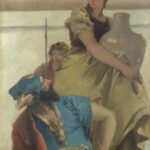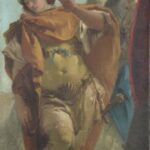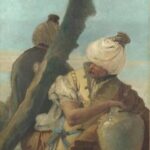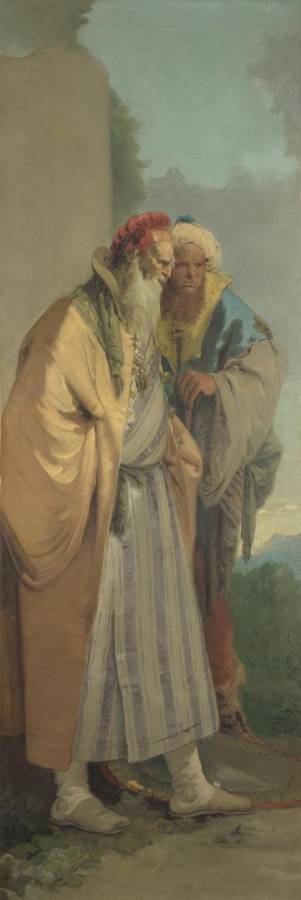Tiepolo, Giambattista (1696-1770)
Il mago d’Ascalona con lo scudo magico ai piedi (The Wizard of Ascalona with the Magic Shield under his Feet)
c.1740–1746
Oil on canvas, 159.1 × 53.3 cm
National Gallery, London
Two men, wearing stunning robes and headdresses made of luxurious fabrics, stand huddled together. Giovanni Battista Tiepolo’s lively outlines and visible brushstrokes emphasise the long, showy sleeves and folds of the clothing. Hints of primary colours appear against more sombre tones, while the brilliant sunlight and subtle shade pick out the men’s expressive faces and textured beards. Tiepolo was immensely skilled at drawing faces, which is particularly noticeable here in the weathered complexion of the aged man closest to us.
This is one of four paintings that once decorated a room in the Palazzo Cornaro on the Campo San Polo, Venice. The figures are inspired by Torquato Tasso’s Jerusalem Delivered, a popular sixteenth-century poem that tells of the ill-fated love between a Christian knight (Rinaldo) and a Saracen sorceress (Armida). The characterful old man with a fluffy white beard is probably the magician of Ascalon who, after showing Rinaldo heroic images of warfare in a shield, lures him back to fight. The shield lying at the man’s feet reappears in another painting from the same series, Rinaldo turning in Shame from the Magic Shield. (NG)
The other paintings in the series:
 Tiepolo, Giambattista (1696-1770)
Tiepolo, Giambattista (1696-1770)
Adrasto assiso ai piedi d’Armida
c.1740–1746
National Gallery, London
 Tiepolo, Giambattista (1696-1770)
Tiepolo, Giambattista (1696-1770)
La vergogna di Rinaldo
c.1740–1746
National Gallery, London
 Tiepolo, Giambattista (1696-1770)
Tiepolo, Giambattista (1696-1770)
Tisaferno e Vafrino
c.1740–1746
National Gallery, London
These four narrow canvases were painted during the 1740s by Giovanni Battista Tiepolo to decorate a room on the second floor of the Palazzo Cornaro on the Campo San Polo, Venice. Tiepolo was enjoying growing fame across Italy at this time; receiving important commissions for large ceiling paintings and wall decorations.
The paintings formed part of a complex decorative scheme, with which a ceiling painting (now in Canberra) and four allegorical figures (now divided between New York and Amsterdam), have been associated. Tiepolo’s four paintings in the National Gallery – Rinaldo turning in Shame from the Magic Shield, Seated Man, Woman with Jar and Boy, Two Standing Figures and Two Men seated under a Tree – are inspired by Torquato Tasso’s popular sixteenth-century poem Jerusalem Delivered. Set during the First Crusade, a Christian military campaign to recapture Jerusalem from Islamic rule, the poem tells of the ill-fated love between the Saracen sorceress Armida and Rinaldo, a Christian knight. Tiepolo’s pale pastel tones and lively brushwork in these scenes create a dazzling atmosphere that evokes the poem’s setting. (NG)
See also:
• Tasso, Torquato (1544-1595)
